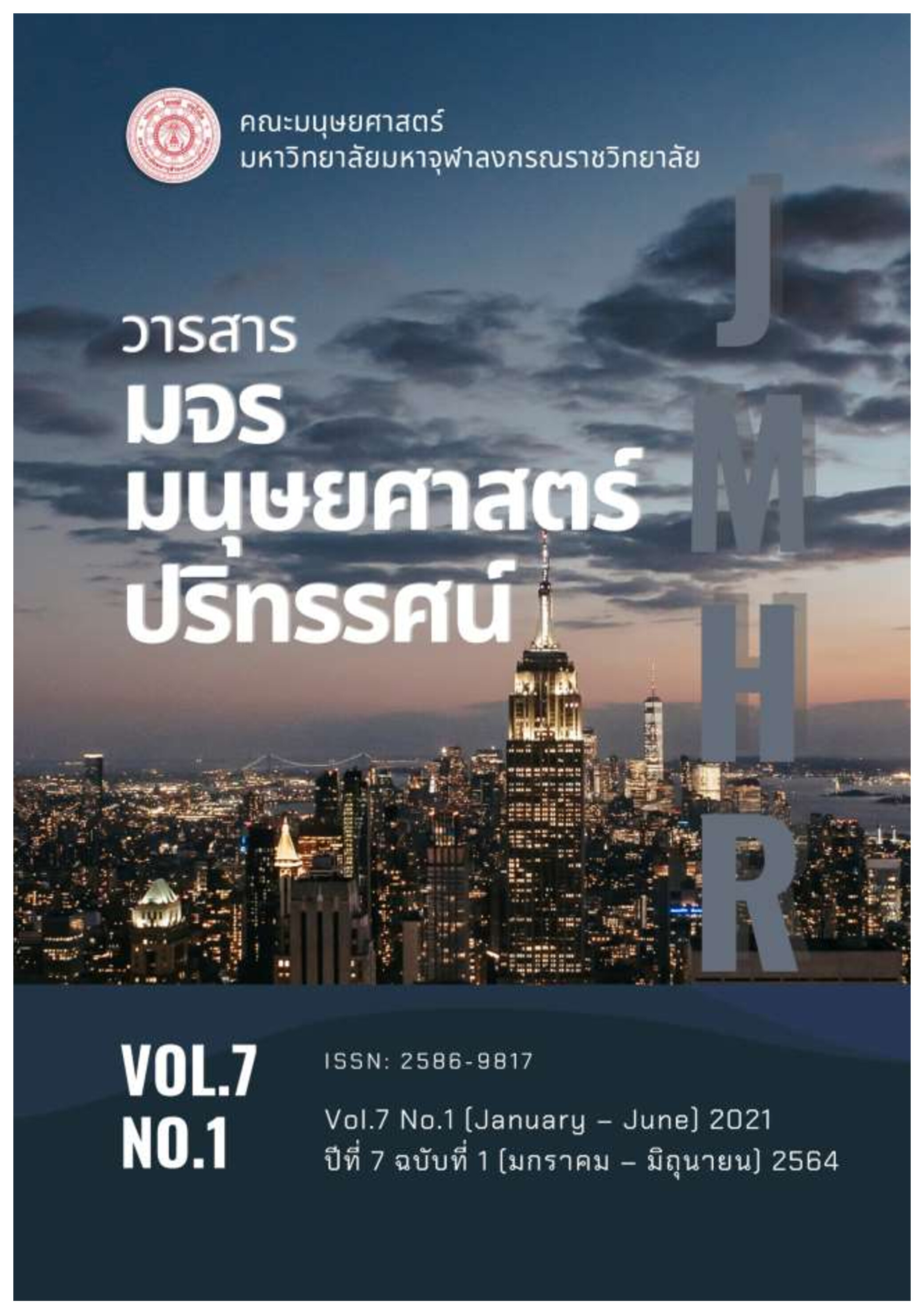บทบาทของทาสเจดีย์กับการสร้างรัฐศาสนาในชุมชนโบราณ เมืองพุกาม ประเทศเมียนมาร์
คำสำคัญ:
บทบาท, ทาสเจดีย์, รัฐศาสนา, เมืองพุกาม, ประเทศเมียนมาร์บทคัดย่อ
บทความวิชาการนี้มีวัตถุประสงค์ 3 ประเด็น คือ (1) เพื่อศึกษาแนวคิดเรื่องทาสและทาสเจดีย์ในพระพุทธศาสนา (2) เพื่อศึกษาเมืองพุกามด้านประวัติศาสตร์และความสำคัญ และ (3) เพื่อศึกษาบทบาทของทาสเจดีย์ด้านพระพุทธศาสนาที่เมืองพุกาม ใช้วิธีการศึกษาเชิงเอกสารจากข้อมูลปฐมภูมิ คือ พระไตรปิฎกภาษาไทย ฉบับมหาจุฬาลงกรณราชวิทยาลัย จำนวน 1 เล่ม คือ เล่มที่ 28 และ ข้อมูลทุติยภูมิ จำนวน 20 รายการ ประกอบด้วย หนังสือวิชาการ จำนวน 13 เล่ม รายงานการวิจัยจำนวน 1 เล่ม วารสาร จำนวน 5 เล่ม และเอกสารอิเล็กทรอนิกส์ จำนวน 1 รายการ นำเสนอเชิงพรรณนาวิเคราะห์
ผลการศึกษาพบว่า เมืองพุกามเป็นราชธานีที่รุ่งเรืองด้วยอารยธรรมแบบพระพุทธศาสนาในประเทศเมียนมาร์ ในอดีตพุกามมีโครงสร้างการปกครองที่ประกอบด้วย (1) พระมหากษัตริย์ (2) เจ้าเมือง คือพวกเมียวทุคยี (Myothugyi) และ (3) ทาส คือ คยูน (Kyun) และทาสที่นายอุทิศให้พระพุทธศาสนาเรียกว่า พยาคยูน (Paya Kyun) ทาสนั้นเป็นชนชั้นกรรมาชีพมีฐานะทางสังคมที่ต่ำสุด ทาสที่นายทาสอุทิศให้กับพระพุทธศาสนามีหน้าที่ในการสร้าง และทำนุบำรุงศาสนสถาน เรียกว่า “ทาสเจดีย์” ในความเป็นรัฐของอาณาจักรพุกามนั้น มีเอกลักษณ์ความเป็นรัฐศาสนา โดยมีทาสเจดีย์เป็นกลไกในการช่วยสร้างรัฐ ซึ่งมีองค์ประกอบ 5 ประเด็น คือ (1) สร้างอัตลักษณ์รัฐด้วยพุทธศาสนา (2) ขจัดลัทธินอกรีต (3) ยึดมั่นในพระรัตนตรัย (4) สร้างระบบศักดินา (Feudalism) ที่เอื้อต่อความมั่นคง และ (5) กระจายอำนาจการปกครองในระบบศักดินา (Feudalism) ทาสเจดีย์เหล่านี้ จึงเป็นผู้ปิดทองหลังองค์พระเจดีย์แห่งเมืองพุกาม กลุ่มทาสเหล่านี้ถึงแม้มีฐานะทางสังคมที่ต่ำ แต่ทรงคุณค่า คือ ได้สร้างสรรค์พุทธศิลปะให้อนุชนได้ชื่นชม และฝากไว้เป็นมรดกให้กับอารยธรรมของประเทศเมียนมาร์ตราบเท่าทุกวันนี้
เอกสารอ้างอิง
เจษฎา ทองขาว และคณะ. (2542). พระพุทธศาสนากับศักดิ์ความเป็นมนุษย์: ท่าทีและการปฏิบัติต่อทาส. วารสารนิติสังคมศาสตร์ มหาวิทยาลัยเชียงใหม่, 10(2), 90-91.
จำนงค์ ทองประเสริฐ. (2542). พระพุทธศาสนากับสังคมและการเมือง. กรุงเทพฯ: ต้นอ้อ 1999.
ทัศสภา อุมะวิชนี. (2557). การปะทะกันของแนวคิดอุดมการณ์สมัยใหม่ในงานประวัติศาสตร์ นิพนธ์ทาสยุคโบราณ. วารสารประวัติศาสตร์ ธรรมศาสตร์, 1(1), 12-57.
นวลจันทร์ คำปังสุ. (2551). เมียนมาร์. พิมพ์ครั้งที่ 3, กรุงเทพฯ: หน้าต่างสู่โลกกว้าง.
บุญเทียม พลายชมภู. (2549). เมียนมาร์: ประวัติศาสตร์ อารยธรรม และความสัมพันธ์ระหว่างประเทศ. กรุงเทพฯ: โอเดียนสโตร์.
บุญสืบ อินสาร, (2555). พจนานุกรมบาลี-ไทย ธรรมบทภาค 1-4 ร่วมฉลองจตุรมงคล, กรุงเทพฯ: อมรินทร์พริ้นติ้งแอนด์พับลิชชิ่ง จำกัด (มหาชน).
ประพันธ์ กุลวินิจฉัย. (2557). วิเคราะห์เรื่องพระพุทธรูปในฐานะปูชนียวัตถุของชาวพุทธ,วารสารวิจัยพุทธศาสตร Buddhist Research Journal, 1(1), 111.
พระเจ้าบรมวงศ์เธอ กรมพระจันทบุรีนฤนาถ. (2537). ปทานุกรม บาลี ไทย อังกฤษ สันสกฤต (พิมพ์ครั้งที่ 4). กรุงเทพฯ: มหามกุฎราชวิทยาลัย.
พระพรหมคุณาภรณ์ (ป.อ.ปยุตฺโต). (2553). กาลานุกรม พระพุทธศาสนาในอารยธรรมโลก, นครปฐม: วัดญาณเวศวัน.
พระมหาโพธิวงศาจารย์ (ทองดี ป.ธ.9). (2559). พจนานุกรมไทย-บาลี, กรุงเทพฯ: วัดราชโอรสารามราชวรวิหาร.
พระศรีคัมภีรญาณ. (2557). พจนานุกรมพระไตรปิฎกภาษาไทย ฉบับมหาวิทยาลัยมหาจุฬาลงกรณราชวิทยาลัย (รายงานการวิจัย). สถาบันวิจัยพุทธศาสตร์: มหาวิทยาลัยมหาจุฬาลงกรณราชวิทยาลัย.
พิพัฒน์ พสุธารชาติ. (2545). รัฐกับศาสนา บทความว่าด้วยอาณาจักร ศาสนจักร และเสรีภาพ. กรุงเทพฯ: ศยาม.
ภภพพล จันทร์วัฒนกุล. (2555). ประวัติศาสตร์และประวัติศาสตร์ศิลปะเมียนมาร์, กรุงเทพฯ: เมืองโบราณ.
มหาจุฬาลงกรณราชวิทยาลัย. (2539). พระไตรปิฎกภาษาไทย ฉบับมหาจุฬาลงกรณราชวิทยาลัย. กรงเทพมหานคร: โรงพิมพ์มหาจุฬาลงกรณราชวิทยาลัย.
มัลลิกา ภูระธน พระระพิน พุทฺธิสาโร. (2559). เมียนมาร์: พระอึดอัดที่วัดมนูหะ การสื่อสารทางการเมืองและตัวตน. วารสารพุทธศาสนาอาเซียนศึกษา, 1(1), 57-72.
วิกิพีเดีย สารานุกรมเสรี. (2563). ทาส. สืบค้น 1 กุมภาพันธ์ 2562, จาก https://th.wikipedia.org/wiki/
วิรัช นิยมธรรม. (2551). คิดแบบเมียนมาร์ ว่าด้วยชาติและวีระบุรุษในตำราเรียน.มหาสารคาม: สำนักพิมพ์มหาวิทยาลัยมหาสารคาม.
สุธิดา ตันเลิศ. (2555), ข่า : ทาสในมณฑลลาวตะวันออกและมณฑลลาวตะวันออกเฉียงเหนือระหว่าง ค.ศ. 1779-1904. วารสารวิจิตรศิลป์, 3(2), 229-296.
หม่อง ทิน อ่อง. (2549). ประวัติศาสตร์เมียนมาร์. (เพ็ชรี สุมิตร, ผู้แปล) (พิมพ์ครั้งที่ 3).กรุงเทพฯ: มูลนิธิโตโยต้าแห่งประเทศไทย.
อัธยา โกมลกาญจน์. (2541). ประวัติศาสตร์อารยธรรมกรีก-โรมัน (พิมพ์ครั้งที่ 5). กรุงเทพฯ: มหาวิทยาลัยรามคำแหง.

ดาวน์โหลด
เผยแพร่แล้ว
รูปแบบการอ้างอิง
ฉบับ
ประเภทบทความ
สัญญาอนุญาต
ลิขสิทธิ์ (c) 2021 วารสาร มจร มนุษยศาสตร์ปริทรรศน์

อนุญาตภายใต้เงื่อนไข Creative Commons Attribution-NonCommercial-NoDerivatives 4.0 International License.





